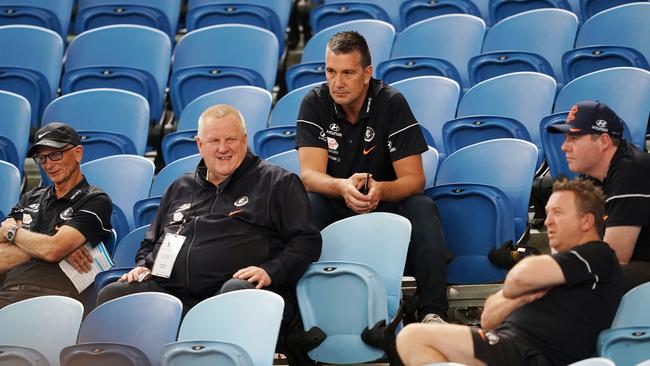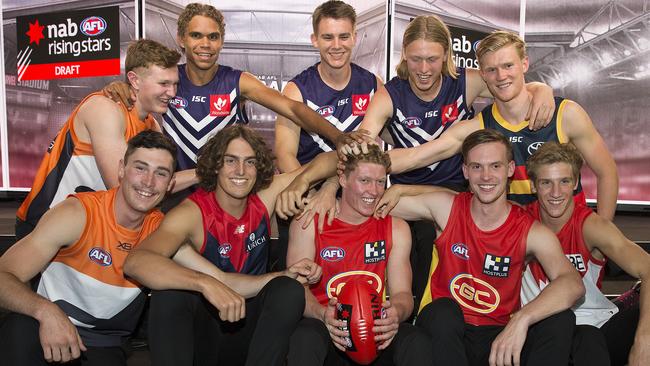Gary Buckenara: How AFL football department cuts will impact trades, recruiting
The impact of savage football department cuts will start to become apparent when the AFL returns, but the real damage could be in how clubs prepare for the trade period and draft, writes expert recruiter Gary Buckenara.
Trade HQ
Don't miss out on the headlines from Trade HQ. Followed categories will be added to My News.
The AFL’s restart will have a different look. There will be no crowds again (at most games) but one of the biggest differences won’t necessarily be noticed by supporters watching at home.
Clubs are operating on skeleton staff and with only 27 football department staff permitted on weekdays and 30 on match-days, resources available to players, including coaches, are limited.
Many have lost their jobs or been stood down, with clubs taking different approaches in choosing who makes up the limited number of coaches and staff allowed. Decisions to remove an assistant coach or two, development staff or members of the strength and conditioning and/or medical teams could be the difference between winning and losing.
When matches begin from Thursday night, we’ll start to see how these off-field decisions will impact performance. Up until now, it’s unknown how much impact the differing decisions of club chief executives, football bosses and senior coaches will have, be it positive or negative.
Players need a good supportive program around them so they can produce their best football, and that includes coaches and medical teams like physios and sports scientists.
North Melbourne shocked many in the footy world by not including assistant coaches Brendan Whitecross (forwards) and Jared Rivers (defence), while Sydney and Western Bulldogs followed by opting not to bring back midfield coaches – Tadhg Kennelly and Jordan Russell and Joel Corey (stoppages) respectively. Melbourne went down a different path with ex-Bulldog Daniel Cross, a member of the club’s fitness staff, not returning while development staff at most clubs are among the casualties.
The decisions clubs have made will be just as critical as players being able to hit the ground running and bank early wins in this shortened season.
But what also can’t be ignored are the active roles off the field in one area in particular – list management and recruiting.

Get your footy fix on KAYO ahead of live matches returning soon. Watch classic battles from the 60s to today, docos, news and more. New to Kayo? Get your 14-day free trial & start streaming instantly >
While there is still a freeze on player contracts, list managers will still be talking to player managers and keeping a close eye on whether players might be considering a trade or free agency move at the end of the season. Deciding on and pursuing key targets from rival clubs and identifying the types of players your club’s list needs is critical to the future of the football club and its ability to challenge for a premiership in the next 2-3 years. A mountain of work goes into this area, so clubs must be mindful of future seasons while still navigating through the present. Getting these decisions right is important.
Collingwood chief executive Mark Anderson said last week Magpies list manager Ned Guy is working on a part-time basis, which surprises me. At Essendon, Adrian Dodoro is essentially working full-time, no doubt going through thousands of hours of vision of potential draftees given the uncertainty around the NAB League this season.
SUBSCRIBE TO THE HERALD SUN FOOTY PODCAST HERE
The reduction in football department spend for the remainder of this season and the reported potential cut of $3 million to the soft cap for the next few seasons means clubs will need to make permanent decisions. My concern is player services – coaches, medical, fitness rehab and IT – will chew up most of the money, leaving limited funds for list management and recruiting teams. Any such move would shortsighted and severely damage a club’s potential to win a premiership in the future.
So how can clubs manage the huge workload of recruiters and list managers – areas that work hand-in-hand – on limited funds while maintaining a similar level of talent identification?
When I took over Hawthorn’s recruiting in 2004, our recruiting team consisted of myself and a part-timer who worked approximately 25 hours per week, plus staff who worked only on weekends in various states.

Before COVID-19 hit, some clubs had up to six full-time recruiters as well as a big team of part-timers who watched games all around the country. List management teams can also consist of 2-3 full-time staff. I doubt we’ll see those types of numbers in these roles any time soon.
The recruiting and list management teams will be hit hard by job losses and recruiting and list managers will need to play a more hands-on role than they have in recent years, including helping with under-18 vision and stats and opposition AFL player information to get maximum benefit from a reduced budget. These departments will likely be made up of mostly part-time staff.
The concern is: Will clubs will miss players like Isaac Smith and Jeremy Howe who were both first spotted playing at lower levels? I believe if players are talented enough to play AFL, especially regional players, they will be found one way or another as most clubs have good networks of people happy to keep an eye out for players dominating local footy.
The biggest challenge will be to find part-time recruiters with a good eye for talent and actually know what they’re looking for – what we call “AFL traits” – who are willing to work for a lot less money than they could have earned previously. Getting the right people on board is critical as the list manager and recruiting manager must be able to trust and value their judgments and, with less travel on the cards where clubs might be unable to see players live, trust will be even more important.
HOW BUCKY WOULD STRUCTURE A LIST MANAGEMENT AND RECRUITING TEAM POST-COVID-19
- 1x list manager
- 1x recruiting manager
- 1x opposition analyst/pro scout
- 1x full-time IT trainee
- 5x part-time recruiters in VIC (paid yearly honorarium approx $3-5K each)
- 3x part-time recruiters based in WA (yearly honorarium approx $3-5K each)
- 3x part-time recruiters in SA (yearly honorarium approx $3-5K each)
- 2x part-time recruiters in TAS, North and South (yearly honorarium approx $3-5K each)
- 2x part-time recruiters in NSW (yearly honorarium approx $3-5K each)
- 2x part-time recruiters in QLD (yearly honorarium approx $3-5K each)
- 1x part-time recruiter in NT (yearly honorarium approx $3-5K)
The 18 part-time recruiters in my structure would work only on weekends during the season, with a total cost of approximately $90,000. Having the staff based in states means no travel would be required, saving clubs at least $20,000, while cutting two full-time recruiters, which is common at clubs, would save approximately $150,000. Staff will need to work for the love of what they do rather than a well-paid role.

HOW BUCKY WOULD STRUCTURE A FOOTBALL DEPARTMENT POST-COVID-19
PLAYER NEEDS:
- Sports science: 1x head of sports science plus 2-3 staff to assist with strength and conditioning program, recovery and rehab.
- Medical team: Sports doctors, physios and psychologists on a per annum agreement with a sports medical practice which can provide these services at training and on game day.
- Massage: Available at training, game days and recovery – paid per hour on weekdays and a set fee on game day.
- Trainers: Paid an honorarium for the year.
- Property: One full-time staff member with volunteers to assist on weekdays and game day.
- IT: One full-time staff member and a trainee to provide coaches and players with vision for team and personal performance, opposition, trends and stats.
- One dietitian to provide correct meals and drinks for players pre and post-game, plus guidance for overall nutrition.
- Player welfare role to support players and provide off-field guidance and assistance where required.
MORE FOOTY NEWS:
Private v public school: The best path to being recruited to the AFL
Mick McGuane on every club’s strengths and weaknesses as AFL returns
Carlton captain Patrick Cripps puts contract talks on hold
AFL injuries 2020: Your club’s injury concerns for every round of the season
COACH NEEDS:
- Coaches also need access to most of the support services available to players outlines above.
- Assistant coaches: Clubs currently have up to 10 assistants and this will be the area hardest hit. Drop to four assistants, with the senior coach taking a more hands-on role.
- Head of football: Role to expand to take more hands-on role in areas including list management and recruiting.
- Football manager: Must be a great all-rounder to provide players and coaches with any assistance they need. Will be a very hands-on role.
- List manager
- Recruiting manager
